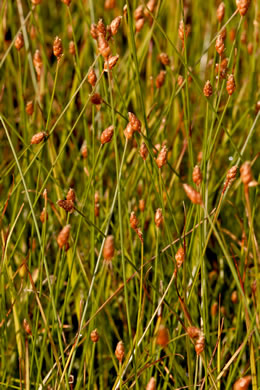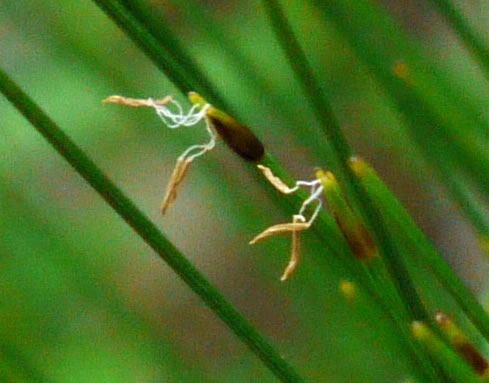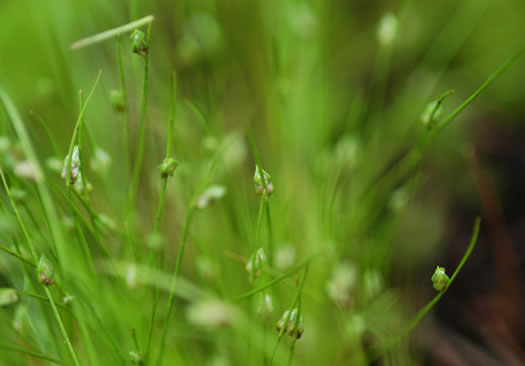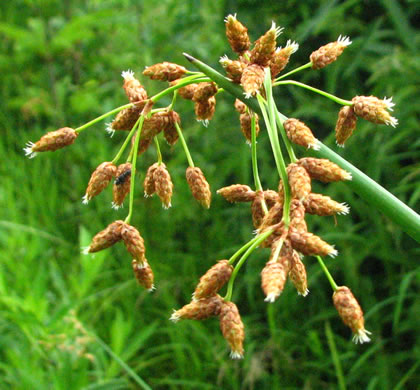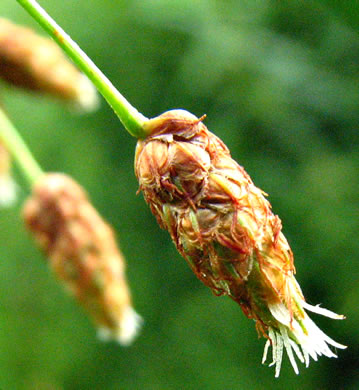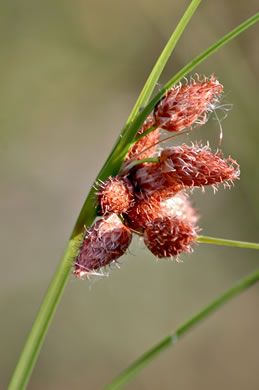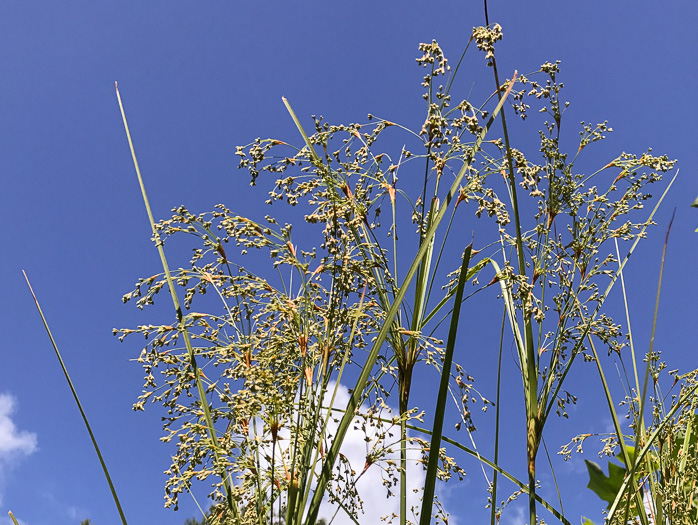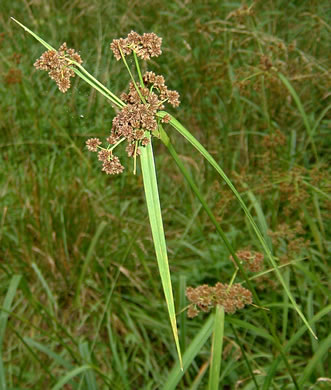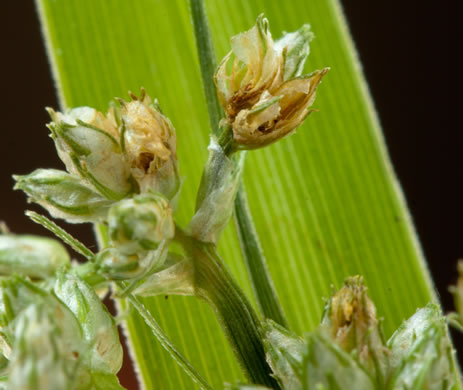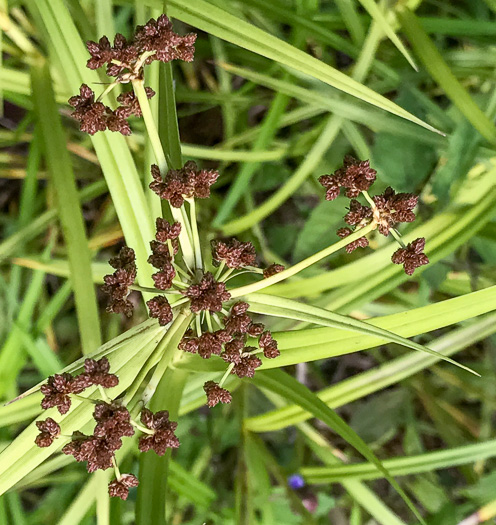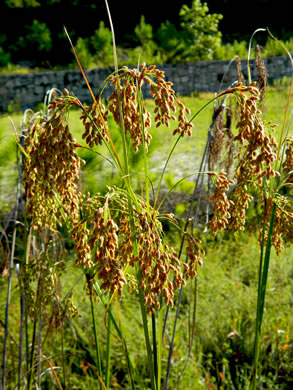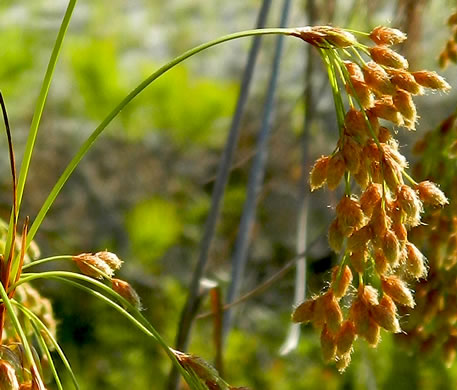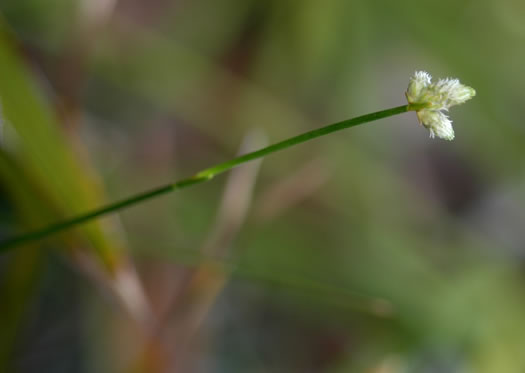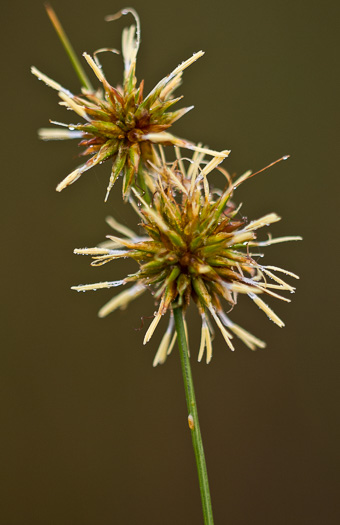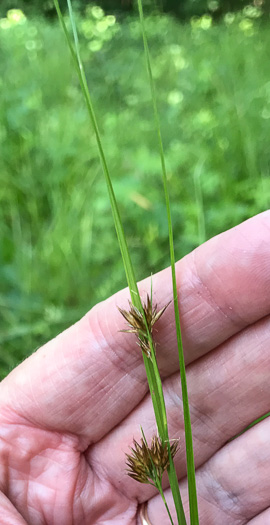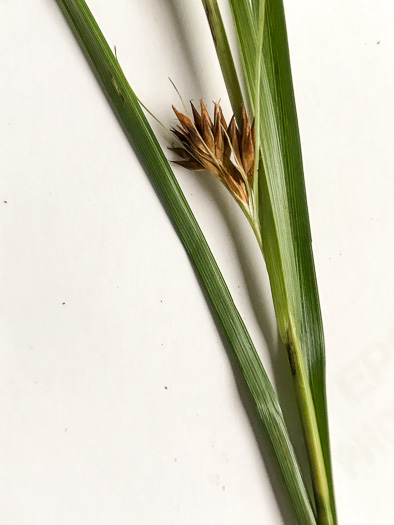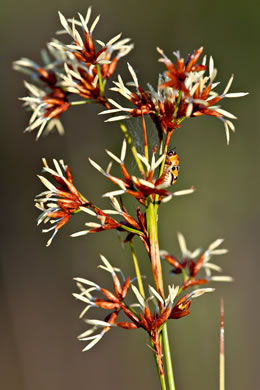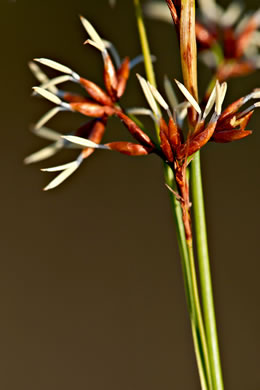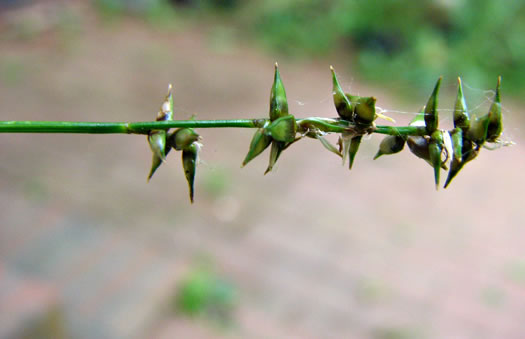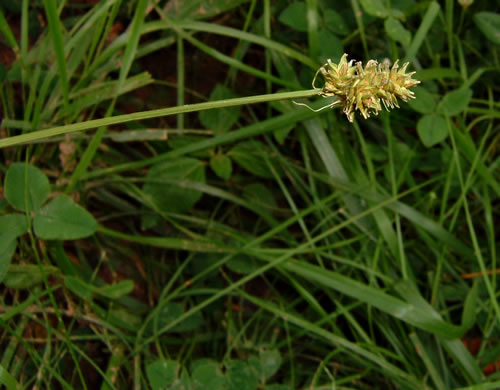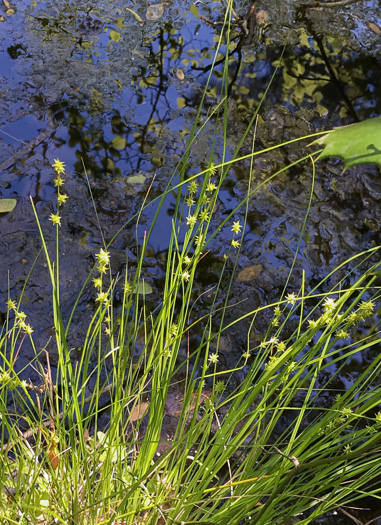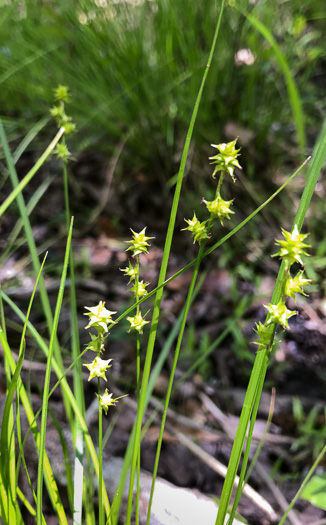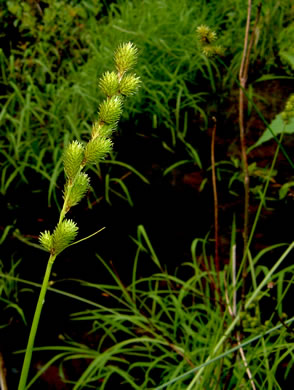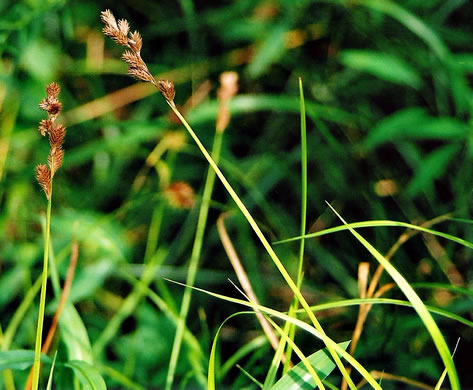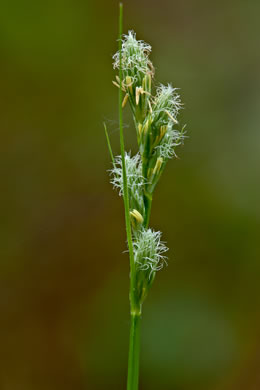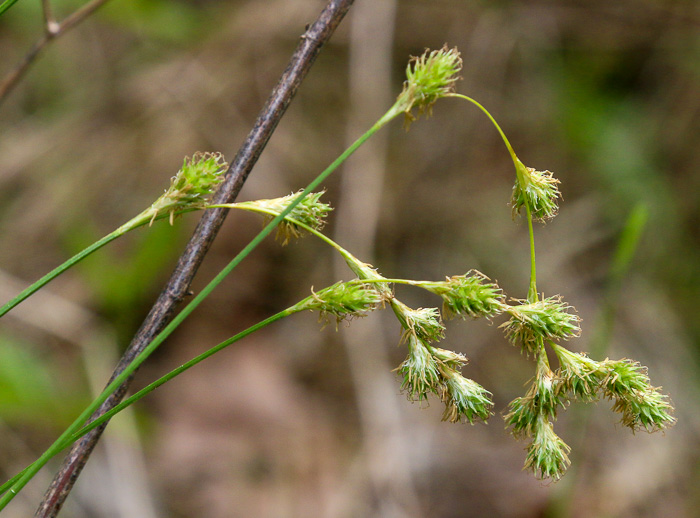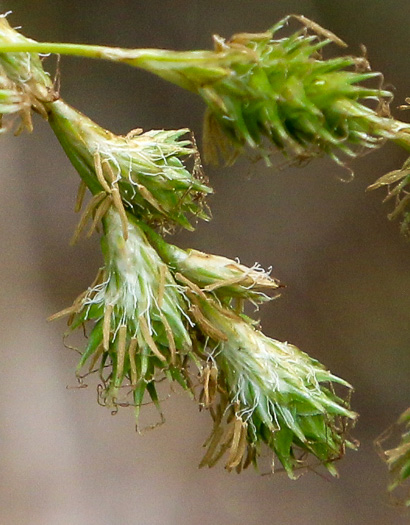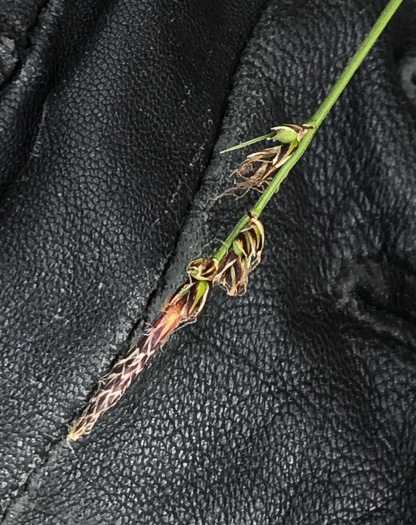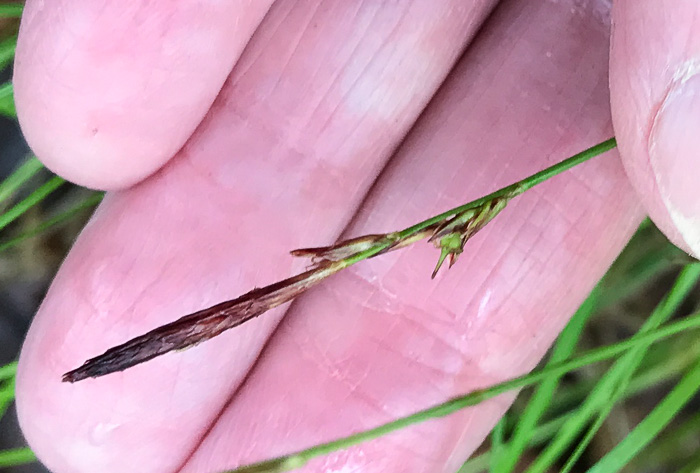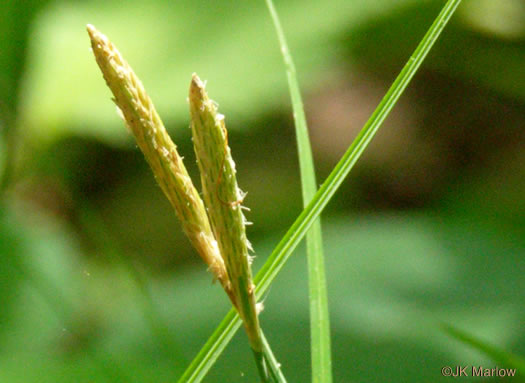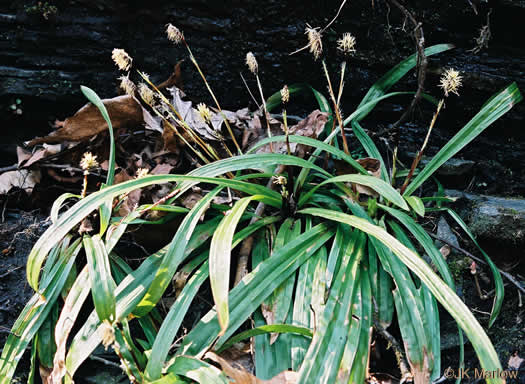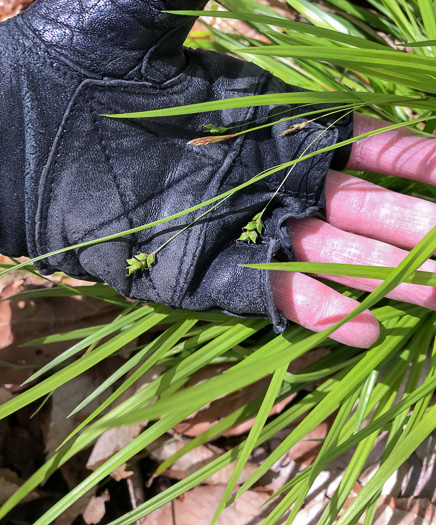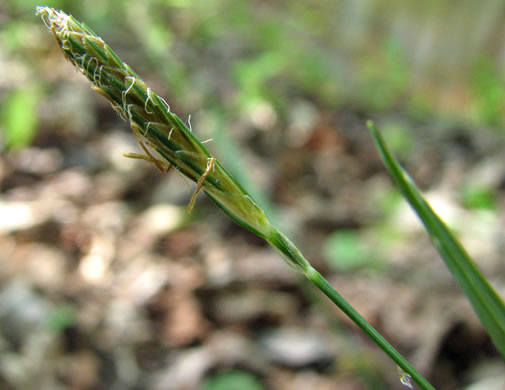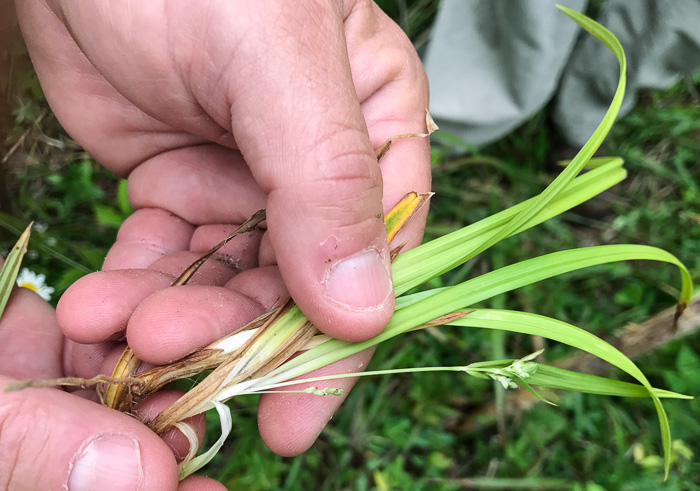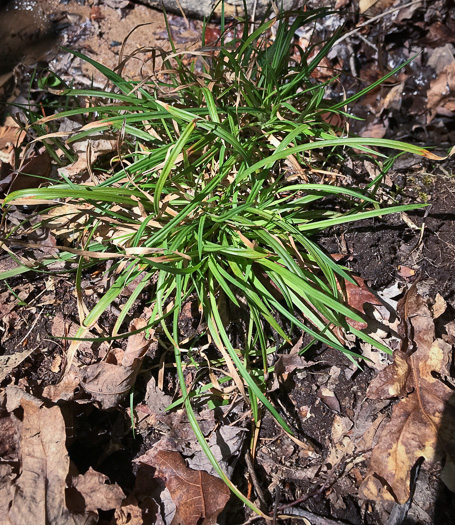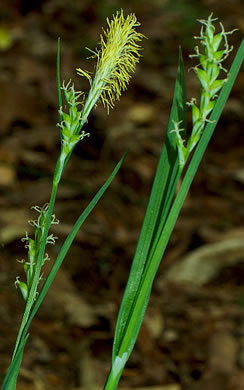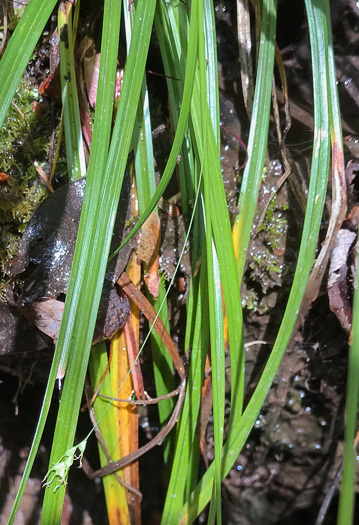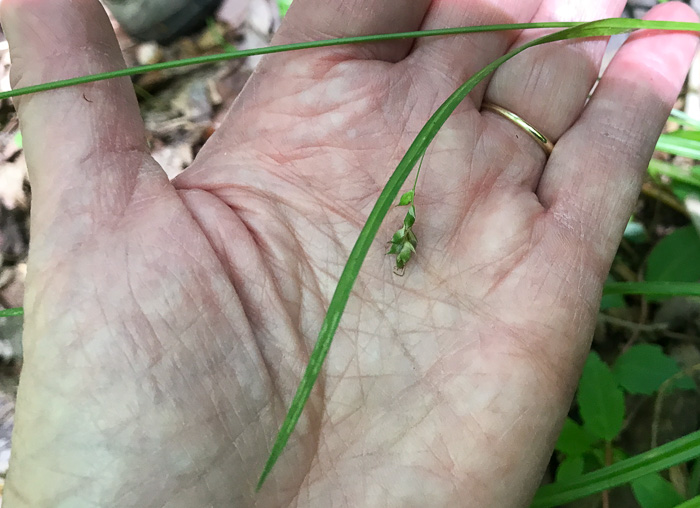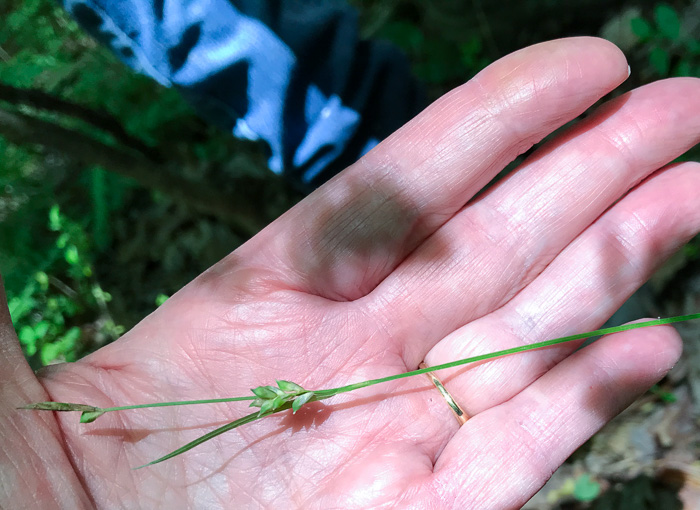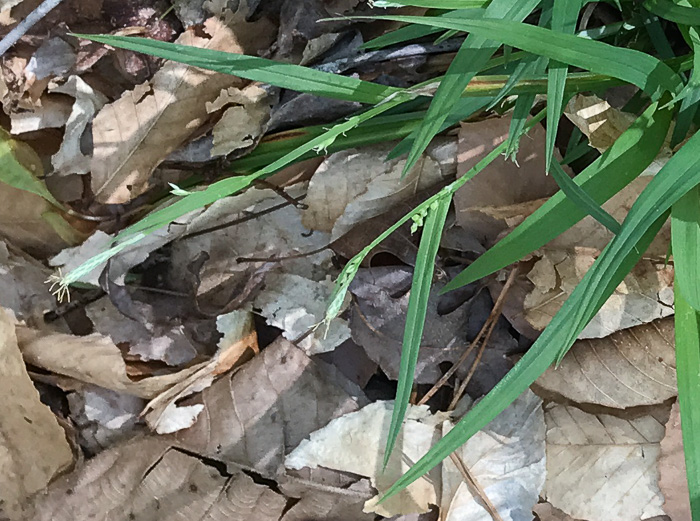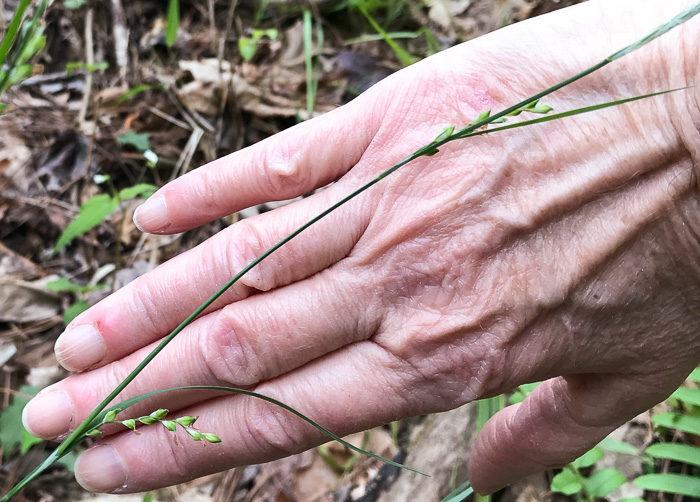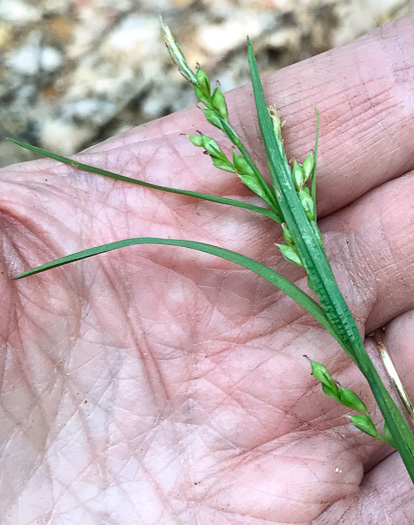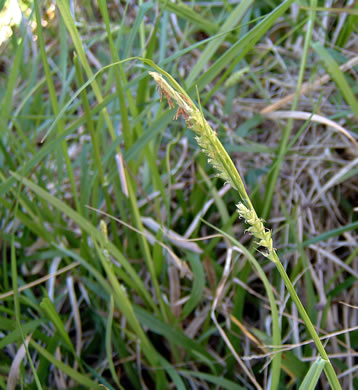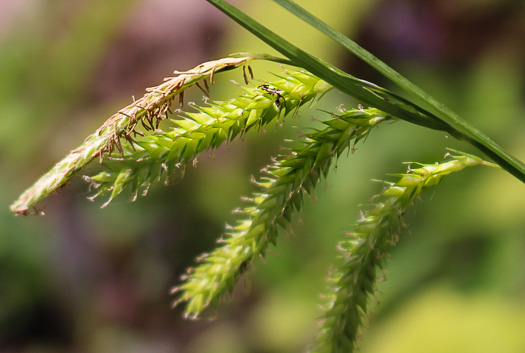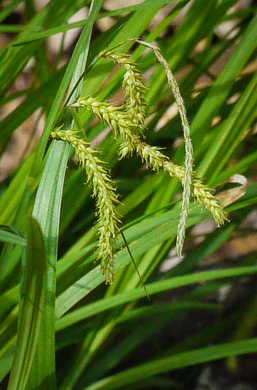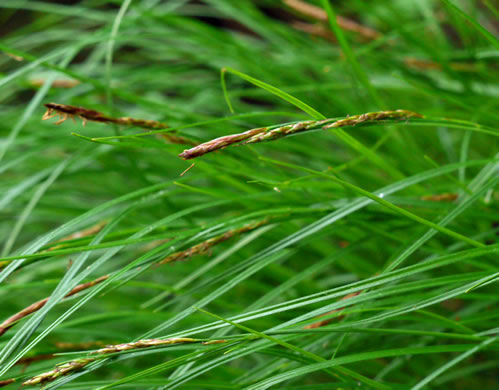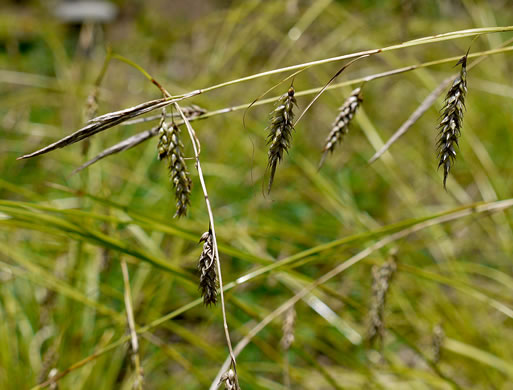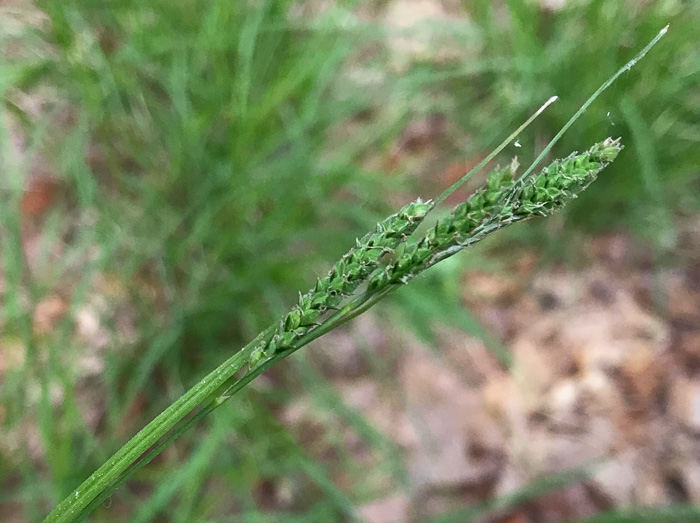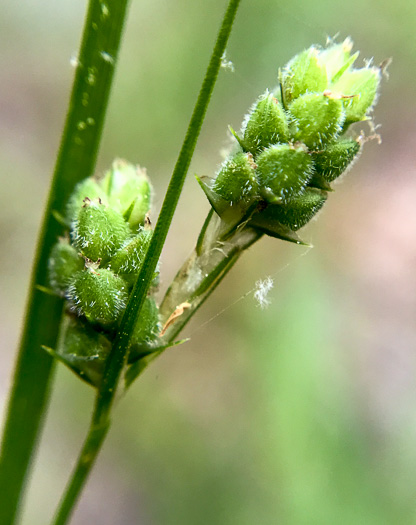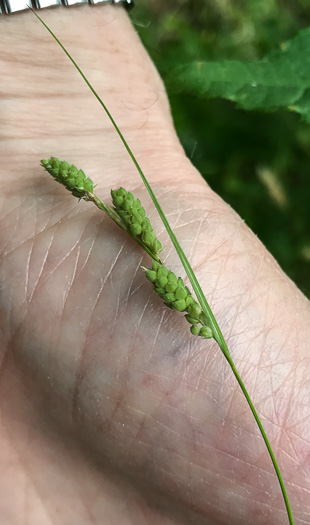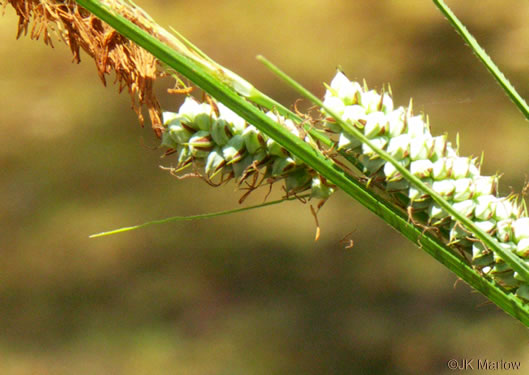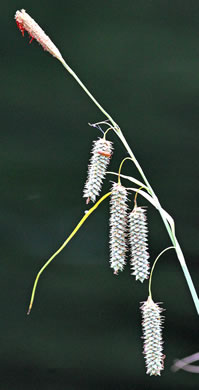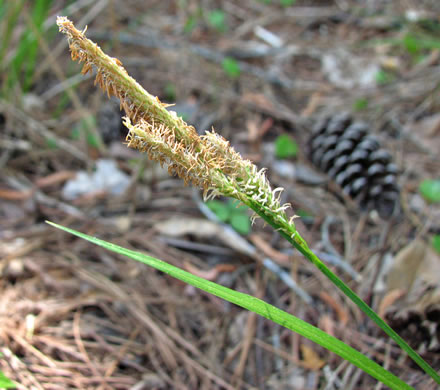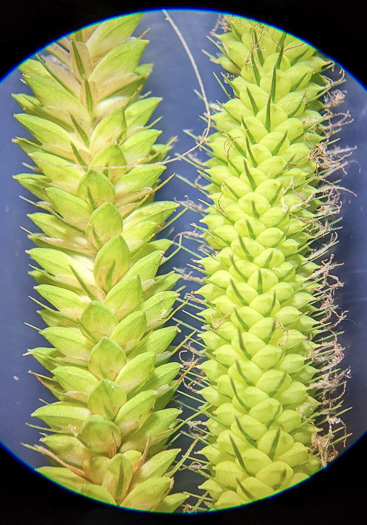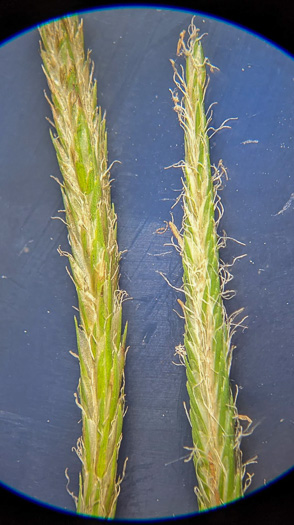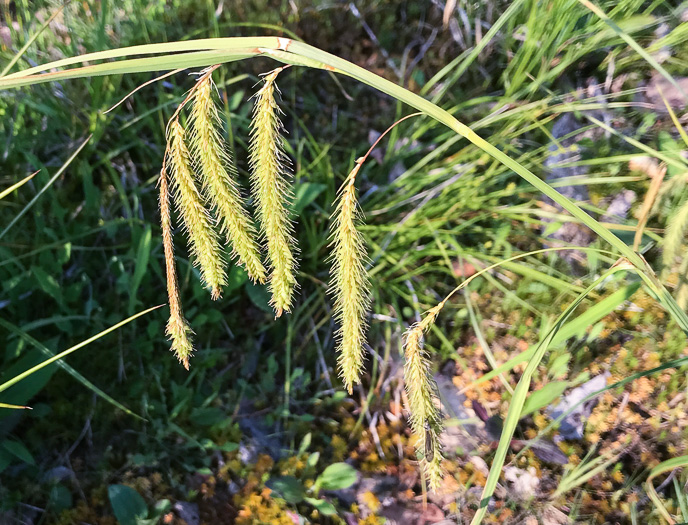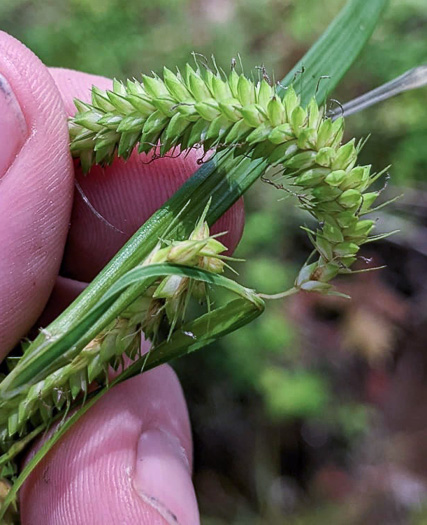Your search found 423 image(s) illustrating the term "spike." For a written explanation, click on "spike" in the Glossary.
PAGE 1 PAGE 2 PAGE 3 PAGE 4 PAGE 5 PAGE 6 PAGE 7 PAGE 8
To see larger pictures, click or hover over the thumbnails.
To go to the plant's detail page, click its name.
 ditch fimbry,
Fimbristylis schoenoides
ditch fimbry,
Fimbristylis schoenoides
Spikelets pale, usually solitary on scape (thus resembling Eleocharis), per Weakley's Flora (2015).
 Deerhair Bulrush,
Trichophorum cespitosum
Deerhair Bulrush,
Trichophorum cespitosum
Spikelet solitary, involucral bract absent, per Vascular Flora of the Carolinas (Radford, Ahles, & Bell, 1968).
 Keeled Bulrush,
Isolepis carinata
Keeled Bulrush,
Isolepis carinata
Inflorescence of 1-3 ovoid, sessile spikelets, per Vascular Flora of the Carolinas (Radford, Ahles, & Bell, 1968).
 Softstem Bulrush,
Schoenoplectus tabernaemontani
Softstem Bulrush,
Schoenoplectus tabernaemontani
Each branchlet ends in one spikelet or a dense cluster of 2-5 spikelets, per www.illinoiswildflowers.info.
 Softstem Bulrush,
Schoenoplectus tabernaemontani
Softstem Bulrush,
Schoenoplectus tabernaemontani
Each spikelet is a compact head of florets and their overlapping scales, per www.illinoiswildflowers.info.
 Saltmarsh Bulrush,
Bolboschoenus robustus
Saltmarsh Bulrush,
Bolboschoenus robustus
Inflorescence relatively congested, most w 5-20 spikelets; bristles ~ caducous, per Weakley's Flora.
 Woodland Bulrush,
Scirpus expansus
Woodland Bulrush,
Scirpus expansus
Resembles S. cyperinus, but lacks the rusty color of the spikelets, per Vascular Plants of North Carolina.
 Georgia Bulrush,
Scirpus georgianus
Georgia Bulrush,
Scirpus georgianus
Spikelets in umbellate clusters or heads. Nutlets whitish; bristles us. absent, per Vascular Flora of the Carolinas (Radford, Ahles, & Bell, 1968).
 Leafy Bulrush,
Scirpus polyphyllus
Leafy Bulrush,
Scirpus polyphyllus
Spikelets ovoid, 3-4mm long, 2-3mm broad, sessile, per Vascular Flora of the Carolinas (Radford, Ahles, & Bell, 1968).
 Leafy Bulrush,
Scirpus polyphyllus
Leafy Bulrush,
Scirpus polyphyllus
Inflorescence branched. Spikelets in umbellate clusters or heads, sessile, per Vascular Flora of the Carolinas (Radford, Ahles, & Bell, 1968).
 Woolgrass Bulrush,
Scirpus cyperinus
Woolgrass Bulrush,
Scirpus cyperinus
Spikelets in large terminal arching clusters, per Wildflowers of Tennessee, the Ohio Valley, and the Southern Appalachians (Horn, Cathcart, Hemmerly, & Duhl, 2005).
 Woolgrass Bulrush,
Scirpus cyperinus
Woolgrass Bulrush,
Scirpus cyperinus
Spikelets ovoid, 3-5mm long, about 3mm wide at base. Scales reddish-brown, per Aquatic and Wetland Plants of Southeastern United States (Godfrey & Wooten, 1979 & 1981).
 Southern Umbrella-sedge,
Fuirena scirpoidea
Southern Umbrella-sedge,
Fuirena scirpoidea
Spikelets ovoid to lance-ovoid, apex blunt, per Flora of North America.
 Tracy's Beaksedge,
Rhynchospora tracyi
Tracy's Beaksedge,
Rhynchospora tracyi
Spikelets in 1-2 globose clusters, per Guide to the Wildflowers of SC, 1st ed. (Porcher & Rayner, 2001).
 Clustered Beaksedge,
Rhynchospora glomerata
Clustered Beaksedge,
Rhynchospora glomerata
Spikelet clusters compact; bracteal leaves mostly exceeding subtended groups, per Flora of North America.
 Clustered Beaksedge,
Rhynchospora glomerata
Clustered Beaksedge,
Rhynchospora glomerata
Spikelets crowded, deep red brown, lance ellipsoid, per Flora of North America.
 Sawgrass,
Cladium jamaicense
Sawgrass,
Cladium jamaicense
Panicle branches bearing several fascicles of spikelets, per Weakley's Flora (2015).
 Sawgrass,
Cladium jamaicense
Sawgrass,
Cladium jamaicense
Spikelets each w one fertile floret, below it 2-3 spirally imbricate scales, per Aquatic and Wetland Plants of Southeastern United States (Godfrey & Wooten, 1979 & 1981).
 Rosy Sedge,
Carex rosea
Rosy Sedge,
Carex rosea
Perigynia not over 4.0mm long, (6)7-14(20) per spike, per Weakley's Flora (2012).
 Oval-leaf Sedge,
Carex cephalophora
Oval-leaf Sedge,
Carex cephalophora
Terminal dense spikes w female flowers protruding outward in all directions, per Forest Plants of the Southeast and Their Wildlife Uses (Miller & Miller, 2005).
 Prickly Bog Sedge,
Carex atlantica
Prickly Bog Sedge,
Carex atlantica
Leaf blades 1.5-3mm wide. Spikes more than 1 per culm, per Vascular Flora of the Carolinas (Radford, Ahles, & Bell, 1968).
 Prickly Bog Sedge,
Carex atlantica
Prickly Bog Sedge,
Carex atlantica
Spikes mostly uniform, sessile. Perigynia broadly ovoid, spreading, per Vascular Flora of the Carolinas (Radford, Ahles, & Bell, 1968).
 Blunt Broom Sedge,
Carex tribuloides
Blunt Broom Sedge,
Carex tribuloides
Inflorescences straight and stiff, the lower spikes overlapping, per Weakley's Flora (2012).
 Blunt Broom Sedge,
Carex tribuloides
Blunt Broom Sedge,
Carex tribuloides
Spikes 6-15, overlapping or distinct, ovoid-oblong to globose, per Flora of North America.
 Long's Sedge,
Carex longii
Long's Sedge,
Carex longii
Inflorescences erect, 1-4.5cm long; spikes slightly separated to congested, per Weakley's Flora (2015).
 Slender Sedge,
Carex tenera
Slender Sedge,
Carex tenera
Inflorescences often flexible and nodding, open, w elongate spikes; rachis usually thin and wiry, per Flora of North America.
 Slender Sedge,
Carex tenera
Slender Sedge,
Carex tenera
Spikes distant or loosely aggregated, ovoid to globose, base tapered or clavate, apex rounded, per Flora of North America.
 Pennsylvania Sedge,
Carex pensylvanica
Pennsylvania Sedge,
Carex pensylvanica
At stem tip, a single staminate spike 0.5-1" long; below this 1-3 pistillate spikes, per www.minnesotawildflowers.info.
 Pennsylvania Sedge,
Carex pensylvanica
Pennsylvania Sedge,
Carex pensylvanica
Spikes stalkless or nearly so, dark purplish brown at flowering time [here w developing fruit], per www.minnesotawildflowers.info.
 Appalachian Woodland Sedge,
Carex austrolucorum
Appalachian Woodland Sedge,
Carex austrolucorum
Inflorescences with both staminate and pistillate spikes, per Flora of North America.
 Wood's Sedge,
Carex woodii
Wood's Sedge,
Carex woodii
Terminal spike staminate, 12-25mm long, about 2mm broad, per Vascular Flora of the Carolinas (Radford, Ahles, & Bell, 1968).
 Seersucker Sedge,
Carex plantaginea
Seersucker Sedge,
Carex plantaginea
Flowering stem usually leafless w a terminal male spike, 3-4 female spikes, per Wildflowers of Tennessee (Carman, 2005).
 South Carolina Sedge,
Carex austrocaroliniana
South Carolina Sedge,
Carex austrocaroliniana
Peduncle of lateral pistillate spikes slender, drooping, 8-11cm, per Flora of North America.
 Spreading Sedge,
Carex laxiculmis
Spreading Sedge,
Carex laxiculmis
Longest staminate spike (10)12-25mm, per Flora of North America.
 Thicket Sedge,
Carex abscondita
Thicket Sedge,
Carex abscondita
Peduncles of proximal spikes usually erect, per Weakley's Flora (2020).
 Cumberland Sedge,
Carex cumberlandensis
Cumberland Sedge,
Carex cumberlandensis
Peduncles of proximal spikes usually drooping or nodding, per Weakley's Flora (2022).
 Lined Sedge,
Carex striatula
Lined Sedge,
Carex striatula
Terminal spike staminate, lateral spikes pistillate, per Vascular Flora of the Carolinas (Radford, Ahles, & Bell, 1968).
 Bent Sedge,
Carex styloflexa
Bent Sedge,
Carex styloflexa
Spikes scattered and densely flowered; perigynium beaks curved, per Weakley's Flora (2022).
 Bent Sedge,
Carex styloflexa
Bent Sedge,
Carex styloflexa
The lowest spike exserted on a long, arching, peduncle, per Weakley's Flora (2022).
 Bent Sedge,
Carex styloflexa
Bent Sedge,
Carex styloflexa
Staminate spike prominent and exceeding the uppermost bract, per Weakley's Flora (2022).
 Broad Loose-flowered Sedge,
Carex laxiflora
Broad Loose-flowered Sedge,
Carex laxiflora
Spikes scattered, loosely flowered; staminate spike prominently exserted, per Weakley's Flora (2022).
 Radford's Sedge,
Carex radfordii
Radford's Sedge,
Carex radfordii
Perigynia 3-10 per spike, loosely overlapping, ascending, obovate; beak slightly recurved, per Flora of North America.
 Blue Ridge Purple Sedge,
Carex manhartii
Blue Ridge Purple Sedge,
Carex manhartii
The leaflike bract of terminal female spike exceeds male spike (vs. shorter in C. purpurifera), per Vascular Plants of North Carolina.
 Meadow Sedge,
Carex flaccosperma
Meadow Sedge,
Carex flaccosperma
Peduncles of terminal spikes barely to much exceeding lateral spikes, per Flora of North America.
 Meadow Sedge,
Carex flaccosperma
Meadow Sedge,
Carex flaccosperma
Lateral spikes pistillate, with 12-39 perigynia, per Flora of North America.
 Necklace Sedge,
Carex prasina
Necklace Sedge,
Carex prasina
Staminate spike 3-4cm long; 2-3 pistillate spikes, 3-4.5cm long, per Vascular Flora of the Carolinas (Radford, Ahles, & Bell, 1968).
 Necklace Sedge,
Carex prasina
Necklace Sedge,
Carex prasina
Pistillate spikes linear, elongate, drooping, per Vascular Flora of the Carolinas (Radford, Ahles, & Bell, 1968).
 Wretched Sedge,
Carex misera
Wretched Sedge,
Carex misera
Spikes reddish-brown; male solitary & terminal, 2-3 female below the male, per Field Guide to the Rare Plants of Georgia (Chafin, 2007).
 Cherokee Sedge,
Carex cherokeensis
Cherokee Sedge,
Carex cherokeensis
Staminate spikes 0-5; androgynous spikes 3-5, peduncles absent or to 12cm long, per Vascular Flora of the Carolinas (Radford, Ahles, & Bell, 1968).
 Ribbed Sedge,
Carex virescens
Ribbed Sedge,
Carex virescens
Differs from C. caroliniana, C. complanata, and C. swanii in its narrower, very long spikes, per Vascular Plants of North Carolina.
 Swan's Sedge,
Carex swanii
Swan's Sedge,
Carex swanii
Terminal spike with over 30% of the flowers pistillate. Perigynia densely pubescent, per Weakley's Flora (2023).
 Swan's Sedge,
Carex swanii
Swan's Sedge,
Carex swanii
Terminal spike gynecandrous [pistillate flwrs above staminate of same spike], per Weakley's Flora (2018).
 Warty Sedge,
Carex verrucosa
Warty Sedge,
Carex verrucosa
Terminal spike staminate, lateral spikes pistillate or androgynous, per Vascular Flora of the Carolinas (Radford, Ahles, & Bell, 1968).
 Blue Sedge,
Carex glaucescens
Blue Sedge,
Carex glaucescens
Stem terminated by a straw-colored male spike and 3-5 female spikes below, per Wildflowers of the Sandhills Region (Sorrie, 2011).
 Blue Sedge,
Carex glaucescens
Blue Sedge,
Carex glaucescens
Male spike terminal, upright, 3-5.5cm long, green turning brown, per Forest Plants of the Southeast and Their Wildlife Uses (Miller & Miller, 2005).
 Tussock Sedge,
Carex stricta
Tussock Sedge,
Carex stricta
[all] spikes erect [none pendant], per Flora of North America.
 Long-fringed Sedge,
Carex crinita var. crinita
Long-fringed Sedge,
Carex crinita var. crinita
Pistillate spike of C. mitchelliana (L) and C. crinita (R).
 Long-fringed Sedge,
Carex crinita var. crinita
Long-fringed Sedge,
Carex crinita var. crinita
Staminate spikes of C. mitchelliana (L) and C. crinita (R) are subtly different. — Eric Ungberg
 Mountain Fringed Sedge,
Carex gynandra
Mountain Fringed Sedge,
Carex gynandra
Spikes pendant: 2-5 pistillate, 1-3 staminate, per Flora of North America.
 Mitchell's Sedge,
Carex mitchelliana
Mitchell's Sedge,
Carex mitchelliana
Pistillate spike.

